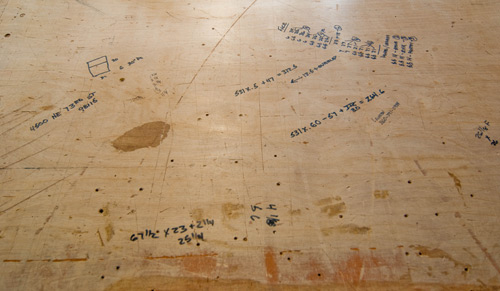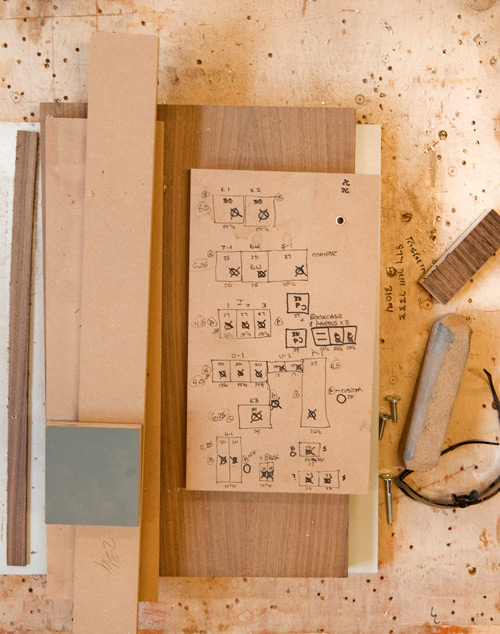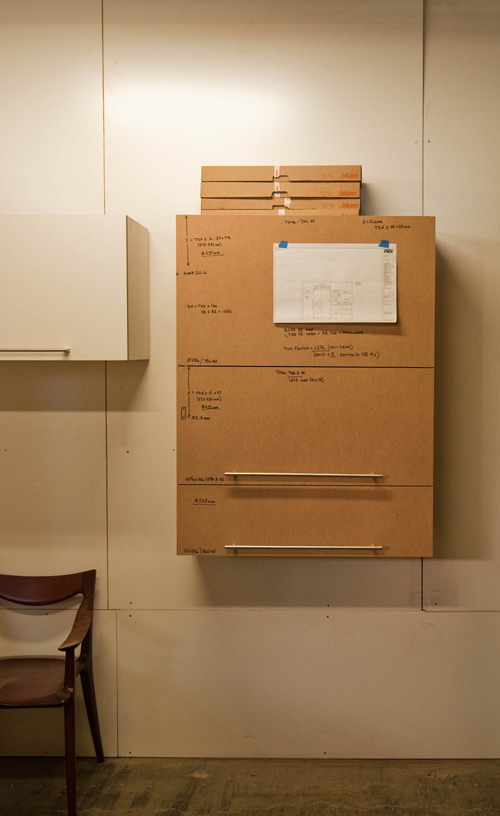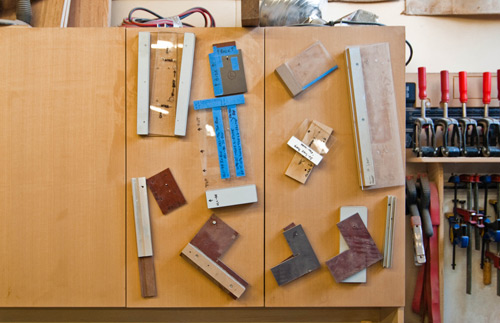
Something struck us the last time we were down at our SPD cabinet and furniture shop; there is an entirely different language of communication, documentation and memory in a wood shop. Accompanying this language is an array of notes, drawings and devices that help us build cabinets and furniture; and while these items may seem commonplace in the context of a wood shop, they’re actually quite fascinating as tools. These are the things that actually make the cabinet shop tick, the things that make work productive, accurate and enjoyable. For today’s post we’re turning the camera around to the things that rarely get photographed and discussed; these are the things that get built to build other things. For as vital as these items are to a wood shop, they don’t get much attention. So here goes, our SPD coverage of notes and jigs.
NOTES
It’s essential to organize the face panels of a cabinet package early on. The wood veneer on SPD cabinet packages is sequenced (meaning that the grain pattern flows from one panel to the next); a handsome and deliberate pattern is dependent on figuring out the number, order and configuration of all the panels. While the drawing below is informally sketched on an off-cut board, it’s one of the most important reference diagrams in the shop. The diagram organizes every door and drawer panel relative to their position in the veneer. The diagram also acts as the key for labeling all of the panels and any other information that could distinguish one panel from the next. Not a single board is cut before the simple diagram is made.

The cabinet box below was built purely for notes. Critical dimensions between the box and the face panels are labeled on the cabinet relative to their position. Think of it like a 3-dimensional notepad.

Walnut veneer sheets are stacked and organized relative to their sequenced position in the grain pattern. Think of it like unrolling sheets of veneer off of a walnut log; this ordering and notation method keeps all the sheets in their proper order within the roll. It allows us to book-match and sequence the cabinet panels in perfect order.

…and nothing says efficient and productive like a to-do list complete with check boxes on an off-cut of MDO.

JIGS
The mounting bracket jig locates drawer faces appropriately on the drawer box. Depending on the drawers location, there may be a full overlay (like the bottom drawer which overhangs the bottom of the cabinet frame) no overlay (at intermediate drawers) or a full inset (like at the top drawer where it stops short of the countertop). There is also the spacing in between drawer faces (typically 1/8” or 1/16”). This set of jigs provides a template for any combination of those variables.

The objects below are placement jigs for hardware offsets; they are placed up against the face of a cabinet box and they indicate exactly where the predrilled holes should be located for attachment of the hardware.

For instance the jig below registers the attachment points for the (4) different types of Blum lift doors.

The pull locator jig below gives us a quick and accurate method to center the drawer pulls on the panel face.

And last but not least, custom furniture jigs are perhaps the most interesting to look at –they’re almost pieces of art in and of themselves.

Cheers from SPD & BUILD





